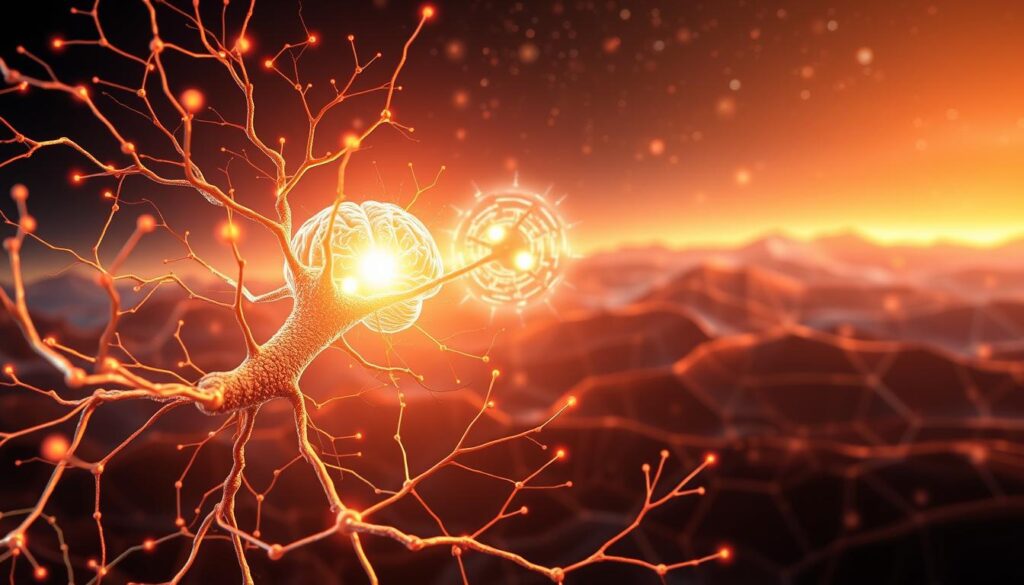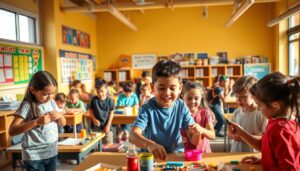Building Confidence in Learning
Did you know 68% of middle and high schoolers say academic pressure makes them question their abilities? This startling reality shows how today’s achievement-focused culture impacts young minds. Many tie their self-worth to test scores or praise, creating a cycle of doubt when expectations feel overwhelming.
But here’s the good news: belief in one’s capabilities transforms how individuals tackle obstacles. Those who trust their skills don’t just memorize facts—they engage deeply, ask bold questions, and bounce back from setbacks faster. This mindset doesn’t just boost report cards; it shapes how people approach challenges throughout life.
Educators now recognize that nurturing this trait is as vital as teaching math or science. When students embrace their potential, classrooms buzz with creative ideas and collaborative energy. Mistakes become stepping stones rather than roadblocks, fueling progress in unexpected ways.
Key Takeaways
- Academic pressure often undermines self-belief, affecting 7 in 10 learners
- Strong self-assurance improves problem-solving and creative thinking
- Risk-taking in education leads to better long-term skill development
- Progress builds momentum—small wins create lasting motivation
- Teachers and parents play crucial roles in shaping resilient mindsets
Understanding Confidence in Learning: Foundations and Benefits

Research reveals a powerful link between students’ self-belief and their classroom achievements. Those who trust their skills tend to approach assignments with curiosity rather than fear. This mindset shift creates ripple effects across all subjects and study habits.
The Role of Healthy Self-Confidence in Academic Success
A Journal of Educational Psychology study tracked learners over nine months. Pupils who started the year believing in their ability to grow scored 17% higher on final exams than peers with similar past grades. Stress management plays a key role—confident students reported 23% less anxiety during tests according to British researchers.
Distinguishing Confidence from Arrogance and Narcissism
Genuine self-assurance doesn’t mean ignoring weaknesses. It’s about balanced self-awareness. Arrogant learners often dismiss feedback, while narcissists crave constant praise. True confidence lets students celebrate others’ wins while pursuing personal growth.
Neuroscience shows why this matters: confident brains form memories 31% faster according to APA data. When learners feel capable, their minds enter “absorption mode”—processing information like sponges rather than panicking about perfection.
Identifying Barriers and Overcoming Low Self-Confidence

When homework turns into nightly battles, it’s often a sign of underlying issues many learners face. Nearly 40% of teens report physical stress symptoms like headaches before exams, signaling deeper struggles with self-doubt.
Silent Struggles in Classrooms
Students lacking assurance often develop “academic freeze” during group work or tests. Their heart rates spike 22% higher than peers during presentations, according to UCLA research. This anxiety leads to missed opportunities—skipped questions, unfinished tasks, and withdrawn participation.
Social withdrawal frequently follows. A 2023 Child Mind Institute study found 1 in 3 middle schoolers avoids lunchrooms due to fear of judgment. As one counselor notes:
“Isolation becomes both symptom and cause—students hide to avoid embarrassment, then fall further behind.”
When Pressure Backfires
External expectations create invisible weights. Girls in competitive school districts show 31% higher cortisol levels during study sessions. Past mistakes also linger—67% of students who failed a major test still reference it years later.
| Barrier Type | Common Triggers | Physical Signs | Academic Impact |
|---|---|---|---|
| Anxiety | Group projects, pop quizzes | Shaking hands, nausea | 15% lower participation |
| Social Withdrawal | Lunch periods, team activities | Quiet speech, slumped posture | 20% fewer completed assignments |
| External Pressures | Parent-teacher conferences | Nighttime teeth grinding | 34% more procrastination |
| Past Failures | Test reminders | Rapid blinking, leg bouncing | 28% longer homework time |
Families feel this strain too. Moms helping with algebra report stress levels matching rush-hour commutes. Breaking this cycle starts with recognizing these patterns early.
Effective Strategies for Confidence in Learning
What separates thriving learners from those who stall? It’s not raw talent—it’s actionable methods that turn challenges into stepping stones. Educators nationwide are finding that simple, consistent approaches create lasting changes in how students approach their work.
Goal Setting and Celebrating Small Wins
Breaking large projects into bite-sized steps helps overwhelmed learners see progress. A 10th grader might tackle a research paper by:
- Outlining three main points on Monday
- Writing one paragraph daily
- Reviewing drafts with color-coded edits
Teachers report 42% more completed assignments when students experience success through micro-goals. Weekly check-ins highlighting improvements—even 5% higher quiz scores—build momentum. “Celebrating effort over perfection changed our classroom culture,” notes Maryland teacher Lena Torres.
Encouraging Self-Expression and Constructive Feedback
Creative projects let learners try new approaches without fear. History classes debating alternate election outcomes or science groups designing eco-cities see 28% more participation. Peer review systems work best when focusing on specific strengths:
| Feedback Type | Effective Phrases | Impact |
|---|---|---|
| Strength-Based | “Your analysis of character motives was spot-on” | +31% engagement |
| Growth-Oriented | “Adding two more data sources could strengthen this” | +24% revisions made |
| Peer-to-Peer | “How did you create that chart? It’s clear” | +19% collaboration |
Regular opportunities to share ideas—through podcasts, art, or coding projects—help students value their unique perspectives. As one 7th grader put it: “When my robot design failed twice, my group cheered my third try. Now I know persistence pays off.”
Neuroscience and Psychological Insights for Academic Success

Ever wonder why some students bounce back from failures while others give up? The answer lies in brain chemistry and adaptable thinking patterns. Modern research shows how dopamine surges and neural rewiring shape educational outcomes more than raw talent.
Understanding the Role of Dopamine and Memory Formation
When learners solve tough questions, their brains release dopamine—a chemical that acts like a natural high-five. This reward signal does two crucial things: boosts motivation and sharpens memory recall. Studies show students retain information 40% better when they connect it to positive experiences.
Stress blocks the hippocampus—the brain’s filing cabinet for facts. Calm learners access stored information 31% faster during tests. As neuroscientist Dr. Carla Shields explains:
“Joyful practice builds mental highways between ideas—panic creates roadblocks.”
Embracing Growth Mindset and Brain Plasticity
Carol Dweck’s famous growth mindset experiments revealed a game-changing truth: brains change with effort. Students who believed they could “grow their smarts” scored 14% higher in math within months. This approach works because it taps into neuroplasticity—the brain’s ability to rewire itself through practice.
| Brain Function | Role in Learning | Impact of Practice |
|---|---|---|
| Dopamine Release | Motivates repetition of successful actions | +37% task persistence |
| Hippocampus Activity | Stores and retrieves facts | +29% recall speed |
| Neural Pathways | Connects related concepts | +42% creative problem-solving |
Howard Gardner’s theory helps too. By identifying eight thinking strengths, it lets learners focus on their natural abilities. A student strong in visual-spatial skills might diagram essays instead of writing outlines—turning weaknesses into manageable parts.
Conclusion
Imagine classrooms where challenges spark curiosity rather than fear. This vision becomes reality when students trust their capacity to grow. Educators who celebrate progress through small wins and constructive feedback create spaces where effort matters more than perfection.
Schools like Royal Public Schools in San Antonio demonstrate this approach. Their focus on achievable tasks and community support helps learners build resilience. When young people see their potential, they tackle complex problems with renewed energy.
The benefits extend far beyond test scores. Neuroscientists confirm that positive reinforcement strengthens memory pathways while reducing stress. Learners who embrace this mindset develop lasting tools for handling life’s obstacles—from algebra equations to career choices.
Creating these environments requires teamwork. Teachers, families, and peers all contribute to nurturing capable individuals. Together, they help transform classrooms into launchpads for success in school and beyond.
FAQ
How does healthy self-confidence impact academic performance?
What’s the difference between confidence and arrogance in learning?
Can anxiety affect a student’s ability to learn effectively?
How do small wins help build academic resilience?
Why is feedback important for developing a growth mindset?
How does brain plasticity relate to learning success?

Sharon Molly is a content creator in lifestyle, fashion, and travel, delivering style-savvy advice and destination insights to inspire confident living. With a background in digital media, she combines aesthetics with practical guidance for modern women on the go.




